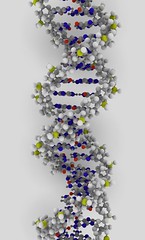 A landmark set of research findings has discovered how the human genome works. The ENCODE project, a massive international effort begun in 2003, picks up where the Human Genome Project left off. ENCODE takes the 3-billion-letter blueprint of the human genome and starts building the user manual.
A landmark set of research findings has discovered how the human genome works. The ENCODE project, a massive international effort begun in 2003, picks up where the Human Genome Project left off. ENCODE takes the 3-billion-letter blueprint of the human genome and starts building the user manual.
The biggest finding is that the 80% of the genome once thought to be largely useless plays key functions in regulating the behavior of genes. This part of the genome switches genes off and on and instructs genes on what to do and when to do it. The genes themselves are encoded in only 2% of the genome, and much of the remainder seems directly involved in the expression of that genetic code.
Ewan Birney, PhD, who worked on ENCODE and the Human Genome Project, told a news conference that the ENCODE results were “the science of the century.” Birney, who is associate director of the European Molecular Biology Laboratory, added, “We are going to be working out how we make humans, starting out from a simple instruction manual.”
The last breakthrough in genetics was eleven years ago when the Human Genome Project completed its genetic mapping. The mapping revealed the blueprint of every human cell but not how the blueprint operated.
ENCODE is a kind of genetic Manhattan Project involving over 400 international scientists and 1,600 experiments that so far have culminated in 30 published studies. The journal Nature has made the data available online for free and has established topic threads so readers can follow aspects of the research across studies.
The ENCODE data promise to transform aspects of medicine. Researchers expect that physicians soon will be diagnosing people more quickly and accurately based on their unique genetic makeup. Today’s genetic counseling and testing have made headway, but ENCODE opens the genetic instruction manual where a few clues existed before.
Along with diagnostics, the new data should spur clinical development of innovative drugs and therapies. Scientists now know which genetic switches control some key cancers and autoimmune diseases. The information gives pharmaceutical and biotechnology companies solid starting points versus hundreds of possibilities, making new investigative research far more feasible.
Clinical researchers have been quick to see the potential and justifiably so, according to comments from Eric Green, MD, PhD, director at NIH for the National Human Genome Research Institute, in a news conference.
Green noted that the encoding portion of the genome, a mere 2%, is responsible for many rare genetic disorders. However, it turns out that many ordinary killers such as heart disease and cancer may be controlled by the switches in the 80% of the genome once thought of as junk. If researchers can decode the switches, they can work on derailing the diseases.
As clinical researchers parse the implications of the new studies, ENCODE scientists still have to determine exactly how the newly discovered mechanisms work. Years of research lie ahead, but they will likely revolutionize aspects of medicine.
Michael Snyder, PhD, director of Stanford University’s Center of Genomics and Personalized Medicine, told the news conference, “We think this will lead to changes in medicine and therapeutic treatment of disease.”
Image Credit: ynse
Derek is an active blogger. This article is for dna diagnostics.










Comments